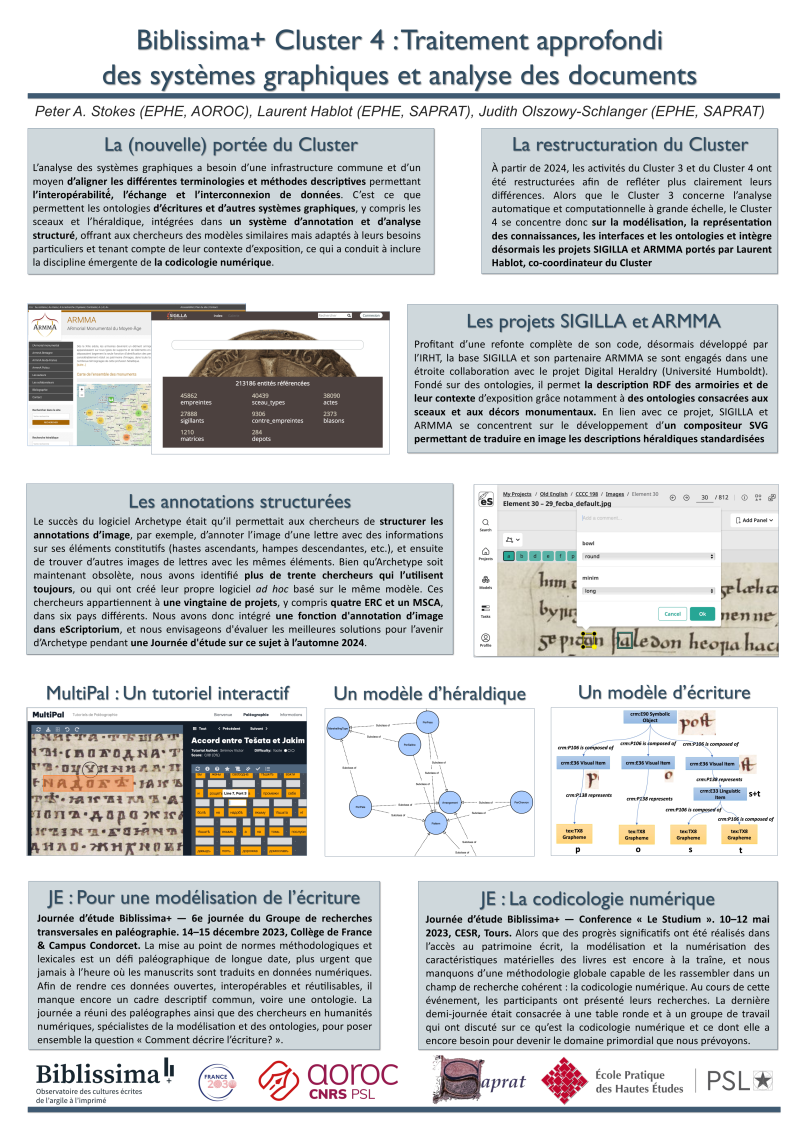


Poster présenté lors des journées annuelles Biblissima+ le 28 mai 2024 à l'Humathèque Condorcet (Campus Condorcet, Aubervilliers).
Stokes, P., Hablot, L., & Olszowy-Schlanger, J. (2024). Biblissima+ Cluster 4 : Traitement approfondi des systèmes graphiques et analyse des documents.
Disponible sur Zenodo : https://doi.org/10.5281/zenodo.11366240
Licence : Creative Commons Attribution
Cluster 4 focusses on the modelling and digital representation of graphic systems and their carriers. These graphic systems include writing but also other forms of communication such as the visual elements in heraldry and seals.
Any analysis of graphic systems needs a common infrastructure, including a way of aligning different terminologies and descriptive methods in order to allow interoperability and the interchange and linking of data. This in turn requires defining one or several ontologies for writing and other graphic systems, and integrating these into a structured system of annotation and analysis which allows researchers to use similar but different models according to their particular needs. It is also clear that any successful model of writing must also take into account the object that carries that writing, and so the cluster also includes the emerging discipline of Digital Codicology.
1/ Ancient script analysis and annotation environment: Archetype and eScriptorium
In order to carry out transversal research in palaeography, it is necessary to define one or more ontologies of scripts and to integrate them into a structured annotation and analysis system.
The Archetype software, which is free and open source, must be entirely redeveloped to ensure its sustainability within e-Scripta. It was designed to provide a visible and reproducible methodology for exploring palaeographic data, communicating it as evidence and arguments, and managing and displaying electronic texts (such as editions and translations, palaeographic and codicological descriptions, etc).
Combined with Kraken and annotation tools within eScriptorium, we will provide an infrastructure with a user-friendly interface for the following tasks :
- Automatic import of images from a IIIF manifest.
- Input of ground truth data to train Kraken and to correct its output.
- Annotation of images according to the writing ontology(ies) developed from Archetype.
- Annotation of texts with TEI XML markup.
- Publication of texts, images and annotations.
- Import and export of data in different standard formats, such as IIIF, PAGE, Alto or TEI XML annotations.
2/ MultiPal to date, locate, read all writings
In the framework of the MultiPal project (interactive tutorial in palaeography), we want to :
- increase the number of exercises in already represented scripts to better reflect their geographical and chronological extent,
- include exercises in other writing systems,
- create, in interaction with Archetype, a Paleographic Album that will serve as a basis for a typology of scripts and as an accessible reference to assist in dating manuscripts.
3/ Modelling forms in Heraldry
In the field of heraldry, we will develop the module already built in e-Signa (SAPRAT, EPHE-PSL), which enables heraldic information to be formalised and returned in the form of a standardised drawing and description. The heraldic search interface will make it possible to query the portal's resources by image or text using a simple graphic reconstruction tool.